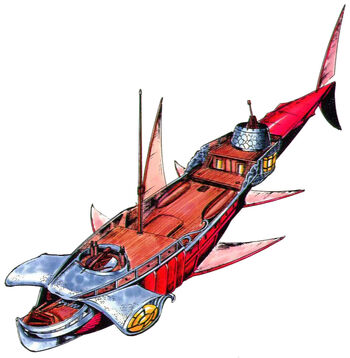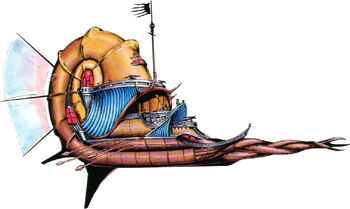Some music!
The Pantless Shadow, Sir Steroid, and The Illestthid pose for the box cover. And Uncle Gary says no, you can't be a mind flayer, you powergaming munchkin twerp!
1989 was a busy year for TSR; in January the 2nd Edition Player's Handbook was released, followed shortly by the Dungeon Master Guide and the MUN-STUSS MAN-YULE. The Spelljammer boxed set was released in August, and that project was spearheaded by Jeff Grub, who seems to have nothing to do with the development of 2e core, though he'd done other work for TSR that makes Frank sad.
I mention this for two reasons: first, I'd like to point out that there are many baffling, arbitrary and at times downright bone-stupid aspects of 2e that Spelljammer is forced to follow, being as it is a 2e product. While there absolutely is a time and a place for taking the Chainsaw of Analysis +4 to 2e, and indeed that has happened in numerous threads here on the Den, I'd like to, as much as is practical, restrict my criticism to the boxed set itself – tracking down the madness of 2e is a far deeper rabbit hole, and some of those rabbits are fiendish dire rabbits and I bruise easily. Jeff Grub and Spelljammer should not be held accountable for the sins of 2e. As we'll see, they have their own sins to answer for anyway.

But enough bullshit preamble!

Inside the box we have:
- 96 page “Lorebook of the Void”
- 96 page “Concordance of Arcane Space”
- a stary-black hex grid, for use with the ship-to-ship combat minigame
- a map of the Rock of Bral, an asteroid-based city suitable as a home base for a campaign
- a poster illustrating the legendary Spelljammer; a gigantic manta ray with towers on it's back
- a map designed to let you track the position of planets within a crystal sphere
- 20 cardstock pages (with some duplicates) of common ships and their deckplans, in color
- a cardstock page of ship silhouettes and plastic feet to go with them, for use with the hex grid
- a cardstock page of planet labels, for use with the planet tracking map
- the ever-present TSR product flyer
MSRP was $18 US, which seems like a shockingly good deal considering how much printed material is in the box, but OTOH that was almost 30 years ago. Times change!

There's no obvious place to begin with the boxed set. As was the style at the time, both books freely mix fluff and crunch, and have information distributed between them in no particular pattern that I can discern – Lorebook has a chapter with detailed descriptions of the various ships, along with pictures. Concordance has a chapter with much shorter blurbs,details on shipboard equipment, and the all-important price information. Really, TSR? I am forced to conclude that they either were trying to shuffle information around so that they could make each book the exact same number of pages, or else their typography staff had their brains sucked out by a mind flayer. However, Lorebook does have a forward, so we'll start there.
So there's our design goals, from The Man Himself. Reading it, I see the following goals:Jeff Grub wrote:
The product you are holding in your hands is the result of a brainstorming session held in a local Lake Geneva restaurant. The designers and editors had been cloistered there to come up with some new ideas and alternatives for the AD&D® game system. The general talk was pretty wild and the waitress asked if we were working for Steven Spielberg, who was rumored to be scouting locations in the area.
If this project is weird enough to be considered a potential movie idea, then we may have done our job here.
The design directive for the SPELLJAMMER supplement was simple: Take the AD&D game into outer space. Then we started adding stuff. It couldn't be like anything ever done before. It shouldn't overturn existing campaigns. Then, "Hey, we've got these 24 pieces of cardboard available, Jeff, how about designing some ships to put on them?" The setting should link together the Realms, Krynn, and Greyhawk without invalidating any of those worlds or the games already set there.
This was becoming a tall order: Maintain the spirit and play of the AD&D game and tie it in with years of previous work without invalidating anything. But if space functions normally, how (for example) do the constellations of Krynn move around without messing up other planets?
Zeb Cook pulled out some medieval woodcuts showing a traveler passing through the spheres of the world to discover the sun and planets on tracks, and with that the idea of crystal shells was born. Each fantasy solar system could have its own placement and rules, while being a part of a larger whole.
That larger whole created its own problems, because space is big. Really big. As I write this, Voyager 2 has just rounded Neptune after a 12-year voyage. Conventional movement
would result in long and empty voyages, which would make for poor role-playing. Yet, everything we see in most fantasy worlds posits an Earthlike world with Earthlike celestial effects.
The need to travel quickly across space brought about the spelljamming helm and with it we cut ourselves fully loose from real science and began creating a "fantasy physics" that was true to its own rules and laws. Dave LaForce (better known as Diesel) and I starting kicking ideas around for gravity planes and atmospheric envelopes, making it possible for the space pirate to stand on the deck of his ship beneath open space.
How does it all work? Well, the easy answer is "It's magic." The more involved answer is "It's magic and it knows it's magic." The rules are still there and must be obeyed, but it is a different set of rules from what we are used to in our world. As anyone here will tell you, a fire-breathing, 50-foot-long, flying reptile is impossible, but it can live in our imaginations. The same argument applies to spelijamming ships.
Jim Holloway started playing with ship types and Diesel began designing both the Spellammer itself and the asteroid base that became the Rock of Bral. Jim was surprised when he brought in five different beholder ship drawings and we accepted them all. Previously, one ship type or style would do for a space-based campaign, but here we had flying things that looked like half walnuts, modified galleons, and giant moths!
The reason for this diversity is to keep with the precepts of our fantasy universe - there are a lot of different races out there and all their ships should not look the same. "Real science" restrictions like aerodynamics are not a concern in worlds with flying carpets and mind flayers. The ships of wildspace reflect this diversity. In many cases, Jim came up with a drawing and then the rest of us showed how it could work.
You'll notice the editors are also listed as developers in the credits. In particular, Steve Winter (general co-ordinator and main editor) and James Ward (design manager and my boss) were responsible for multipie additions and revisions in the text. I would finish a particular section, James would review it and come up with five more neat things we could do with it, and I would scurry back to my computer, giggling and cackling over the new ideas.
Similarly, Steve Winter went over the rules with an eye toward consistency and fun, adding and refining the various pieces of the system into a complete whole. This was a Herculean task. Our main goal was to not to produce a miniature wargame that simplified AD&D game procedures but rather a supplementary system to help DMs and players enjoy ship-to-ship fighting in a most unusual setting.
And there you have it. I once described designing this product as the gaming equivalent of running through a mansion, flinging open the doors, and discovering what lies beyond them. In many ways the size of space itself, the unlimited number of possible encounters, ships, races, monsters, and other neat stuff to be found out there, has proved to be the greatest challenge. This box is the first giant step - not a furtive foothold but a full-tilt charge — into a new universe of gaming.
On behalf of the creators of the SPELLJAMMER supplement, I hope you enjoy the trip.
Jeff Grubb
August 1989
- Create a setting that's AD&D... IN... SPAAAAAAAAACE!
- Tie existing campaign settings together without shitting on the core assumptions of any of them
- Develop a coherent “fantasy physics”
- Permit for a diversity of races and ships
- Provide a ship to ship minigame
With all that said, I'd like to take a moment and be explicit about what I'm planning on focusing my criticism in this OSSR on:
1) Do what extent are the concepts in the product coherent, with themselves and other concepts introduced in the product?
2) To what extent to the game mechanics support those concepts within the framework of AD&D 2e?
So, next post, I'll be looking at Lorebook of the Void, Chapter 1: Campaigns In Space. Excuse me, Campaigns... IN.... SPAAAAAAAAACE!
For those of you who want your Spelljammer fix RIGHT NOW GODDAMNIT please take a look at Frank & AncientHistory's excellent review of a later Spelljammer product, The Complete Spacefarer's Handbook









